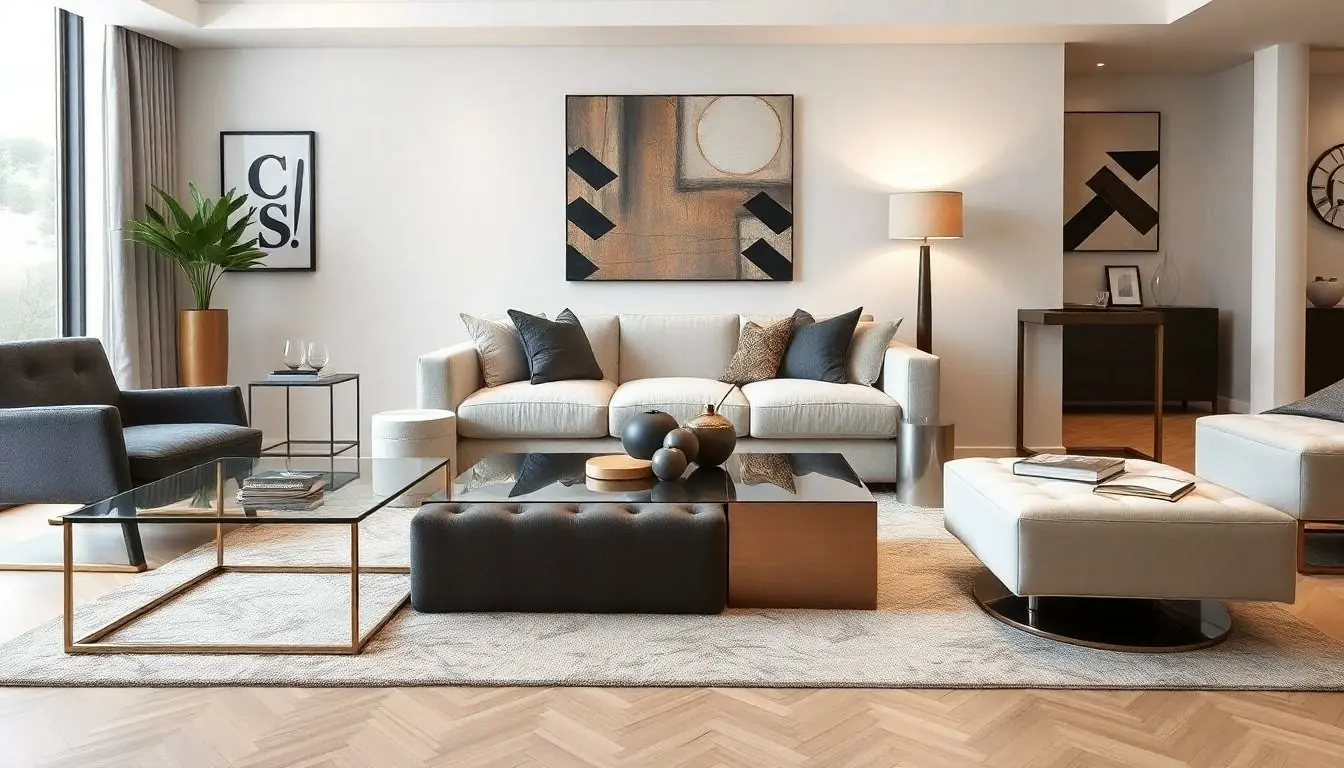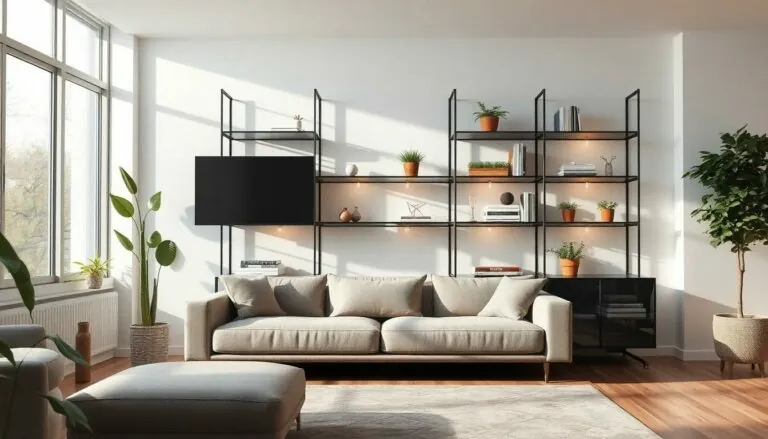A living room without a center table is like a pizza without cheese—just not quite right. These versatile pieces aren’t just for holding snacks during movie night; they’re the unsung heroes of style and functionality. Imagine gathering around a stunning table that sparks conversation and adds flair to your space.
Table of Contents
ToggleOverview of Center Tables for Living Rooms
Center tables play a crucial role in the design and functionality of living rooms. Design choices vary, ranging from minimalist options to ornate styles, allowing for personalization in any space. They provide a centerpiece around which social interactions occur, encouraging engagement during family gatherings or meetings with friends.
Consider different materials like wood, glass, and metal, each offering unique benefits. Wooden tables provide warmth and a classic look, while glass tables create a sense of openness. Metal tables often introduce a modern vibe, blending durability with contemporary design.
Size matters in choosing a center table. It should complement the surrounding furniture without overwhelming the area. Typically, center tables should measure two-thirds the length of the sofa, allowing easy access and comfortable spacing.
Functionality isn’t overlooked when selecting a center table. Options with storage, such as drawers or shelves, enhance utility and help keep the living space organized. Versatile designs that allow for various uses, including a surface for drinks or games, streamline living room activities.
Furthermore, color coordination impacts the overall ambiance. Neutral shades promote a serene environment, while bold hues make a statement. Patterns can also introduce visual interest, aligning with the room’s decor.
Center tables carry weight in living rooms beyond mere decoration. Their practical and aesthetic functions together create a comfortable and inviting atmosphere, central to any home’s social life.
Types of Center Tables

Various types of center tables cater to diverse living room styles and functionalities. Each type provides unique features and aesthetics.
Coffee Tables
Coffee tables often occupy the center of the living room. They provide surface space for drinks, books, and decorative items. Styles range from traditional wooden designs to sleek glass options, allowing flexibility in aesthetics. Height and width can vary significantly, so choosing one that complements surrounding furniture is essential. Many coffee tables also offer storage solutions, such as shelves or drawers, enhancing their practicality in a cozy setting.
Ottoman Tables
Ottoman tables serve multiple purposes beyond aesthetics. They can function as soft seating, footrests, or even storage trunks. Upholstered designs add a layer of comfort and style, making them ideal for casual living rooms. Sizes and shapes differ, with round or square frames fitting seamlessly into various layouts. Selecting an ottoman table that matches the overall decor ensures unity in the living space.
Designer Center Tables
Designer center tables make bold statements in living rooms. Crafted by renowned designers, they showcase artistic flair through unique forms and high-quality materials. Many of these tables feature innovative designs that prioritizes both utility and style. Selecting a designer piece elevates the space, creating a focal point that sparks conversation. Consider pairing these tables with complementary seating to enhance the overall aesthetic.
Material Options
Center tables offer various material options that impact aesthetics, durability, and functionality. Each material presents unique characteristics that make them suitable for different living room styles.
Wood
Wooden center tables exude warmth and timelessness. They provide structural integrity and can effortlessly blend with traditional or modern decor. Popular types of wood include oak, pine, and walnut, each offering different hues and grains. Many wood tables come with options for finishes, allowing customization for personal taste and existing color schemes. Additionally, wood generally withstands daily use, making it a practical choice for households with children or pets.
Glass
Glass center tables add elegance and a sense of space. Often used in contemporary and minimalist designs, they create an illusion of openness in smaller living areas. Tempered glass, a popular choice, enhances safety by reducing the risk of shattering. Glass tables also reflect light, contributing to a bright ambience. Easy to clean, these tables accommodate various styles of bases, including wood or metal, providing versatile design combinations.
Metal
Metal center tables offer a striking contrast with their industrial edge. Materials like steel, aluminum, and wrought iron deliver strength and resilience. Often characterized by sleek lines and modern aesthetics, metal tables pair well with modern and eclectic decor. Their durability makes them suitable for high-traffic areas, resistant to scratching and denting. Many metal tables feature interesting designs, showcasing artistic craftsmanship, while others focus on minimalism and functionality.
Choosing the Right Size
Selecting the appropriate size for a center table significantly impacts the living room’s functionality and aesthetics. Considerations include dimensions that complement existing furniture, ensuring a harmonious arrangement.
Standard Sizes
Standard center table dimensions often range between 36 to 48 inches in length for rectangular tables, while round tables typically measure 30 to 42 inches in diameter. The height usually aligns with sofa seat height, generally around 16 to 18 inches. Tables within these size ranges enhance comfort, encouraging easy access to drinks and snacks.
Proportions for Your Space
Proportionality matters in living rooms. Space between the sofa and table should measure 18 to 24 inches, allowing comfortable movement. In a small room, choose a table that promotes openness while providing necessary surface area. Larger spaces may accommodate more substantial tables, serving as focal points without overwhelming the area.
Style Considerations
Style significantly influences the choice of center tables in living rooms. Selecting a table that complements the room’s design creates harmony and enhances aesthetics.
Modern vs. Traditional
Modern center tables often showcase sleek lines and minimalistic designs, perfect for contemporary spaces. They typically use materials like glass and metal, emphasizing simplicity and functionality. Traditional tables, in contrast, feature ornate details and intricate designs, crafted from rich woods that convey timeless elegance. Each style option appeals to different tastes, permitting homeowners to express their individual preferences through furniture choices.
Color and Finish Options
Color and finish contribute to the overall ambiance of a living room. Light finishes such as oak or birch create an airy feel, while dark woods like walnut or mahogany add warmth and richness. Bold colors like red or blue can serve as statement pieces, instantly drawing attention. Neutral shades promote versatility, allowing for easy integration with existing decor. Each color selection influences emotional responses, making it essential to choose wisely.
Center tables are more than just functional pieces; they’re vital to crafting a welcoming living room atmosphere. By choosing the right design material and size, homeowners can create a space that reflects their personal style while enhancing utility. Whether opting for a coffee table an ottoman or a designer piece each choice contributes to the overall aesthetic and comfort of the room. With endless options available, selecting a center table that harmonizes with existing decor can transform a living room into a true social hub. Ultimately it’s about finding that perfect balance between style and functionality to elevate the entire space.





